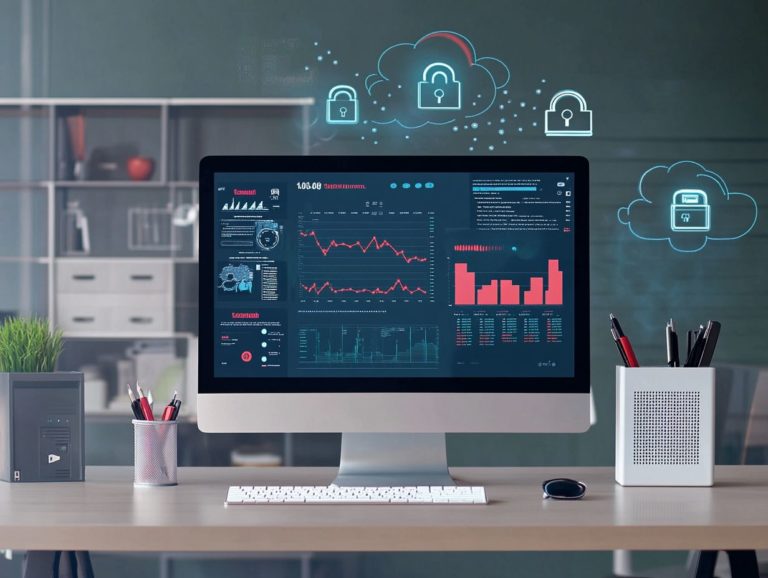5 Key Considerations for Cloud Security Architecture
As businesses continue their shift to the cloud, understanding the nuances of cloud security architecture has become crucial for protecting confidential information.
Let s explore five key considerations that can help you build a strong security framework.
From pinpointing potential threats to enforcing stringent access controls, each section tackles vital components of cloud security.
You will encounter common challenges, the need for customization tailored to your organization’s unique requirements, and emerging trends that are shaping the landscape.
Whether you re a seasoned IT professional or just starting your journey, this guide offers valuable insights to elevate your cloud security strategy.
Contents
- Key Takeaways:
- 1. Understanding Cloud Security Architecture
- 2. Identifying Potential Threats and Risks
- 3. Implementing Strong Access Controls
- 4. Ensuring Data Privacy and Compliance
- 5. Regularly Testing and Updating Security Measures
- What Are the Common Challenges in Implementing Cloud Security Architecture?
- How Can Cloud Security Architecture Be Customized for Different Organizations?
- What Are the Key Components of a Strong Cloud Security Architecture?
- Want to Protect Your Data in the Cloud? Here’s How!
- What Are the Benefits of Implementing a Cloud Security Architecture?
- What Are the Future Trends in Cloud Security Architecture?
- Frequently Asked Questions
- What are the key benefits of a well-designed cloud security architecture?
- How can I ensure the security of my data in the cloud?
- What is the role of identity and access management in cloud security architecture?
- How does a multi-cloud environment impact cloud security architecture?
- What are the best practices for ensuring continuous security in a cloud environment?
- How can I stay updated with the latest trends and developments in cloud security architecture?
Key Takeaways:

Understanding the basics of cloud security architecture is crucial for protecting data and systems in the cloud. Strong access controls, regular testing, and updates are essential for maintaining a secure cloud environment. Following 5 steps to secure your cloud environment and customizing your cloud security architecture to fit your organization’s specific needs is key to maximizing its effectiveness.
1. Understanding Cloud Security Architecture
Understanding cloud security architecture is essential if your organization deploys applications in cloud environments. This is particularly crucial when using technologies like Kubernetes and PostgreSQL within a microservices architecture, as outlined in the 5 security considerations for PaaS.
A robust security posture depends on following good practices for cloud tools and infrastructure as code. Implementing strategies for effective cloud security management will help establish a clear architecture to protect your data and applications from various cyber threats.
Key components, such as network security, play a pivotal role in safeguarding data in transit. Furthermore, identity management ensures that only authorized users can access critical resources.
Embracing the shared responsibility model allows you to clearly outline security responsibilities between your organization and your cloud service provider. Major industry players, including AWS, Google Cloud, and Azure, offer unique tools and frameworks that support these security components, enabling you to enhance your defenses while focusing on innovation.
2. Identifying Potential Threats and Risks
Identifying potential threats and risks in cloud environments is critical for maintaining a robust security posture and preventing data breaches through effective vulnerability management and incident response strategies.
As your organization increasingly relies on cloud services, you expose yourself to various threats, including unauthorized access and data leaks. These vulnerabilities may arise from misconfigured settings, weak authentication measures, or even third-party integrations.
By implementing continuous monitoring solutions, you can detect suspicious activity and respond proactively. Conduct regular risk assessments to identify gaps in your security protocols, allowing for timely updates and adjustments.
Staying informed about evolving threats is essential for protecting your data and maintaining customer trust in today s increasingly digital landscape.
3. Implementing Strong Access Controls
Implementing strong access controls is vital for safeguarding the sensitive information you store in cloud environments. Ensure that user authentication and identity management measures are in place, along with robust API security and encryption practices.
These controls also protect data integrity and help you achieve regulatory compliance, which is vital in industries that manage personal or financial information.
Consider employing various mechanisms, such as role-based access control (RBAC), a method of assigning user permissions based on job roles. This approach significantly minimizes the risk of unauthorized access.
Adding multi-factor authentication (MFA) introduces a crucial layer of security, requiring users to provide multiple forms of verification before access is granted. Together, these strategies create a robust framework that strengthens your organization’s defenses against potential breaches while ensuring operational efficiency.
4. Ensuring Data Privacy and Compliance

Ensuring data privacy and compliance in cloud environments is complex. You must pay attention to industry standards like SOC reports and ISO/IEC 27001 while implementing a robust zero trust model.
You navigate a complex web of regulations, including GDPR and HIPAA. These regulations dictate specific mandates for data protection and user privacy.
Ignoring these frameworks can lead to substantial fines, reputational damage, and a significant erosion of customer trust.
To effectively mitigate risks, it’s essential for you to adopt best practices such as:
- Regular audits
- Employee training on compliance standards
- Establishing clear data governance policies
By fostering a culture of accountability and transparency, you ensure adherence to regulations. This significantly enhances your overall security posture.
5. Regularly Testing and Updating Security Measures
Regularly testing and updating your security measures is essential for maintaining a robust cloud security posture. This ensures that your performance tuning, backup strategies, and disaster recovery plans are not just implemented but also continuously monitored for effectiveness.
This proactive approach protects sensitive data and lays a solid foundation for tackling emerging threats. By conducting routine security assessments and penetration testing, you can identify vulnerabilities before malicious actors exploit them.
Quickly update your procedures to stay ahead of newly discovered risks. This is crucial for remaining competitive in the ever-evolving cybersecurity landscape.
Incorporating these practices into your regular protocols enhances not just your security measures. It also boosts your organization s ability to respond swiftly and effectively to potential breaches.
What Are the Common Challenges in Implementing Cloud Security Architecture?
Common challenges in implementing cloud security architecture include navigating visibility issues, understanding cost implications, and managing the shared responsibility model. To address these, you should focus on the key elements of a cloud security strategy, while effectively utilizing automation to streamline security processes and enhance compliance.
You may grapple with the complexity arising from diverse cloud environments. A lack of complete transparency can create vulnerabilities.
Without clear insights into your multi-cloud setups, your IT teams might struggle to identify potential risks or inefficiencies, complicating compliance with various regulations.
Managing data privacy in a cloud-centric world adds another layer of complexity. To tackle these challenges, adopt advanced monitoring solutions that offer real-time visibility.
Regular training for your teams on compliance requirements, paired with automated tools, significantly simplifies governance and fortifies your overall security posture.
How Can Cloud Security Architecture Be Customized for Different Organizations?
Cloud security architecture can be tailored specifically for your organization by assessing your unique requirements, regulatory obligations, and the technologies you employ. Implementing strategies for secure cloud migration allows you to create solutions that align precisely with your operational needs and risk profiles.
For example, if you re part of a financial institution, prioritize stringent data encryption and multi-factor authentication to meet compliance mandates. Conversely, if you re a startup in the tech sector, your focus may lean more towards agile deployment and scalability.
Large enterprises can gain a significant advantage by implementing infrastructure as code. This automates security configurations to ensure consistency and minimize human error.
Meanwhile, healthcare organizations need robust access controls to protect sensitive patient information. This reflects the specific regulatory landscape they navigate.
By evaluating these various elements, you can effectively adapt your cloud security measures. This fosters a secure environment that meets the demands of your industry.
What Are the Key Components of a Strong Cloud Security Architecture?

A robust cloud security architecture includes essential components such as strong network security protocols, effective identity management systems, and advanced encryption techniques. To enhance your understanding, consider exploring the 5 must-know cloud security frameworks that protect sensitive data and ensure compliance with industry standards.
Each component plays a crucial role in establishing a strong environment that reduces threats and vulnerabilities. Network security protocols serve as your first line of defense, diligently monitoring traffic to thwart unauthorized access.
Identity management systems verify that only authorized users can access critical resources. They employ multi-factor authentication a security method requiring more than one verification step and role-based access controls to enhance security.
Encryption techniques elevate your security posture by transforming sensitive information into an unreadable format, safeguarding data both in transit and at rest. Together, these components interconnect seamlessly, creating a resilient and comprehensive security framework that adapts to emerging threats.
Want to Protect Your Data in the Cloud? Here’s How!
It’s crucial to implement effective backup strategies, robust disaster recovery plans, and encryption techniques that safeguard sensitive information against breaches and loss.
Start by adopting regular automated backups for easy restoration in case of data loss. Store these backups offsite for enhanced security.
Conduct frequent disaster recovery testing to uncover potential vulnerabilities and equip your teams to respond swiftly to unexpected incidents.
Prioritize regular audits of your data protection policies and practices to maintain compliance with industry standards and effectively defend against evolving threats.
What Are the Benefits of Implementing a Cloud Security Architecture?
Implementing a cloud security architecture provides many benefits, including enhanced risk management, improved compliance with regulations, and increased visibility into your security processes. Understanding the key features of a cloud security strategy ultimately leads to a more robust security posture.
Organizations report significant reductions in security breaches after adopting cloud security frameworks. For example, a leading healthcare provider that shifted to a cloud-based system experienced a remarkable 40% decrease in incident response times, allowing for quicker containment of potential threats.
A major financial institution discovered that strong cloud security tools enabled them to meet stringent regulatory requirements with greater efficiency, resulting in reduced audit costs.
By leveraging these architectures, you can enjoy improved data integrity and a lower total cost of ownership, generating measurable savings and bolstering stakeholder confidence in your commitment to security.
What Are the Future Trends in Cloud Security Architecture?
Future trends in cloud security architecture increasingly favor automation, artificial intelligence, and multi-cloud strategies. These advancements allow you to strengthen your security posture while navigating complex cloud environments.
Automation enhances real-time threat detection and refines incident response protocols. By incorporating AI-driven security analytics, you can proactively pinpoint vulnerabilities and adjust your defenses as needed.
As you embrace multi-cloud environments, tackle the unique security challenges that arise from this complexity. Implementing automation tools enables seamless integration and continuous monitoring across various platforms. This ultimately helps you maintain a robust security framework throughout diverse cloud ecosystems.
Frequently Asked Questions

What are the key benefits of a well-designed cloud security architecture?
A well-designed cloud security architecture provides several benefits, such as enhanced data protection and improved compliance with regulations, as well as steps to optimize your cloud security posture, which lead to increased scalability, agility, and cost savings on infrastructure.
How can I ensure the security of my data in the cloud?
Key considerations for cloud security architecture help secure your data. These include strong authentication, data encryption, and regular backups.
What is the role of identity and access management in cloud security architecture?
Identity and access management (IAM) controls who can access your data and services in the cloud. It includes multi-factor authentication, where you need more than one way to prove your identity.
How does a multi-cloud environment impact cloud security architecture?
A multi-cloud setup presents unique security challenges. You must understand the security measures of each provider and coordinate them effectively.
What are the best practices for ensuring continuous security in a cloud environment?
Keep your cloud environment secure by regularly updating your security practices! Conduct vulnerability assessments and monitor all systems closely.
How can I stay updated with the latest trends and developments in cloud security architecture?
Stay current in cloud security by attending industry events and engaging in online discussions. Reading reputable blogs can also keep you informed.






